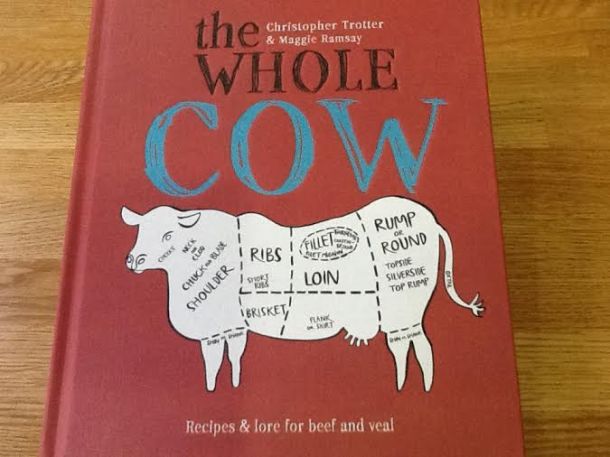
I felt quite adventurous with the next recipe in my ‘nose to tail’ project, cooking every dish in Chef and author Christopher Trotter’s ‘The Whole Cow’ book‘. I decided to make corned beef, a dish I’ve never cooked, but the recipe looked quite straightforward and my local butcher, Drew, shared some of his tips, as well as providing me with a nice looking piece of brisket.

My early memories of corned beef are those square tins with the key and dinner of what we called corned beef hash, really a mash as it was simply chopped corned beef mixed with mashed potatoes. In some places that’s called Stovies as I discovered when I was in Fife recently. This dish had fried onions and corned beef mixed through the mashed potatoes.
There’s an interesting chapter on preserved beef in the The Whole Cow and it gives an insight into the history of preserving meat – ” Salt acts as a preservative by drawing out the moisture: this stops bacteria and moulds from growing because they need water to survive. There are two main methods of salting: rubbing with dry salt or soaking in brine, either of which may take a few days or several weeks”.
“Corned beef and the modern English term ‘salt beef’ are interchangeable, ‘corn’ being an old English word for any grain, including grains of salt. The classic recipe uses brisket or silverside (outside or bottom round), kept in a nice spiced brine for up to two weeks, the resulting meat is usually simmered with onions, carrots and bay leaves, until tender enough to cut with a fork. It’s the basis for the traditional English ‘boiled beef and carrots’, North America’s New England boiled dinner and the Irish- American corned beef and cabbage”.
The first stage was to brine the meat and the recipe advises soaking for at least 2 days or up to 7. As it was my first attempt, I decided to go around halfway and brined for almost 4 days. The brining was a simple process, make the salt cure, allow to cool and soak the meat for 2 days.

Brine. 2 litres cold water, 300g coarse sea salt, 200g coarse brown or granulated sugar, 2 bay leaves, 3 juniper berries, 1/2 tsp saltpetre (optional)
Put all the ingredients into a large pan and bring to the boil, stirring to dissolve the salt and sugar, then leave until cold. Put the meat in a deep non reactive bowl and pour over the cold brine. Leave for at least 2 days, or up to 7
The brine can be used for many other types of meat and Christopher also uses it for ox tongue, pork belly and breast of veal.
Cooking the corned beef was also a simple process, involving a few extra ingredients. 2 carrots, 1 onion studded with 8 cloves, base of a head of celery, 1 head of garlic, cut in half horizontally, bay leaf, thyme and rosemary.
Soak the brined beef in fresh cold water for about 2 hours. Put into a deep pan, cover with cold water, slowly bring to the boil and skim off the grey scum. Add the rest of the ingredients and reduce to a gentle simmer, partially cover and cook for 3 hours or until tender. Leave the cooked meat in it’s cooking liquid to cool slightly and then remove from the pan.
I was delighted with my effort. The beef was tender with subtle lingering flavours of the herbs and spices. Christopher suggests slicing and serving hot with boiled potatoes and mustard or thinly slice for a sandwich, on rye bead with pickles and/or mustard.

The cooked corned beef can also be used to make Potted beef, a Scottish speciality sold in most butcher shops. The recipe in ‘The Whole Cow’ includes prunes, which is Christopher’s own take on the recipe, added after a cooking session with a chef friend.
Potted Beef. 400g freshly cooked corned beef, with it’s cooking liquid, salt and pepper, 10 stoneless ready to eat prunes, ideally Agen, roughly chopped.
Leave the cooked corned beef in it’s cooking liquid to cool slightly, then remove from the pan. Simmer steadily to reduce the cooking liquid by half and then leave to cool.
Chop the beef into small chunks, mixing fat and lean meat, season with salt ( take care if you have brined for a long time) and black pepper.

Mix the prunes and add a little of the cooled stock, just enough to moisten ( about 4 tbsp) and then cram into an earthenware crock pot or bowl, cover and place in the fridge. It is best left for at least 48 hours and will keep happily for up to a week.
Like the corned beef, the potted beef was devoured by the Gillon boys before I could take a picture of the dish. It was a delicious and they enjoyed it with toast and chutney. The serving suggestion from Christopher is to serve from the dish with toast salad and piccalilli, but any tangy salsa will go well.
About the author. Christopher Trotter is a freelance chef and food writer, restaurant inspector and food consultant. As Fife’s Food Ambassador, he organises bespoke food tours around Scotland as well as running cookery classes. He is the author of several books, including the whole hog, Scottish Heritage Food and Cooking with Carol Wilson and the National Trust for Scotland’s The Scottish Kitchen Follow hin on twitter – @CTScotfood or Facebook– /CTSCOTFOOD
ARTWORK – Thank you to Alice Strange for permission to reproduce the ‘cow’ artwork. A full selection of her work can be viewed on her website.